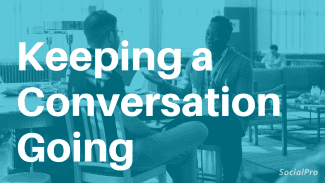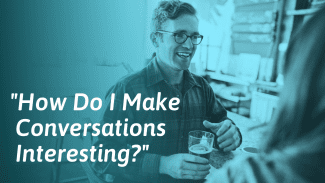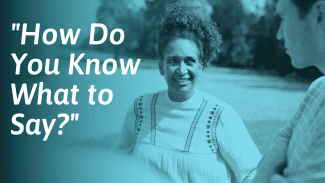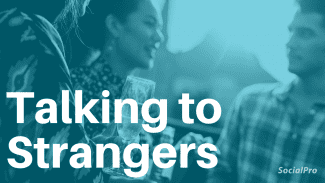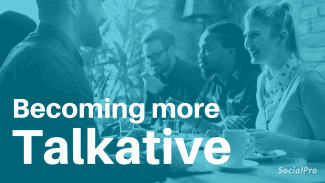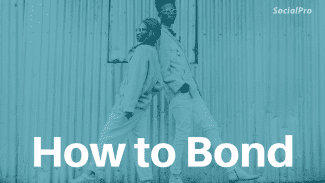Talking to people doesn’t come naturally to everyone, especially when it involves approaching new people. Even after you’ve started a conversation, you might struggle to keep it going or find yourself scrambling for things to say. If you haven’t mastered the art of conversation yet, you’re definitely not alone. Many people feel anxious, awkward, insecure, or unsure of themselves in conversations.
Because having to talk to people is necessary in order to work, function in society, and have a normal social life, conversation skills are something we all need. The good news for those who struggle with them is that these skills can be learned and improved with practice.
Talking to people includes a wide range of different skills. For example, you’ll need to know how to start, continue and end a conversation, and each requires different social skills.[3] In this article, you’ll learn skills and tips that can help you with each stage of a conversation, from start to finish.
Sections
- How to start a conversation with someone
- How to continue a conversation with someone
- How (and when) to end a conversation with someone
- Why is it so hard for you to talk to people?
- Common questions
How to start a conversation with someone
Starting a conversation is sometimes the hardest part, especially with new people, strangers, or people you’re still getting to know. You may feel awkward about approaching someone or like you don’t know what to say when you do. Knowing how to start a conversation is an essential social skill and one you’ll need to use often.
Until you know how to approach people, it will be really hard to form new relationships and friendships. This section will provide tips on how to spark up a conversation or make small talk with anyone—including how to talk to people online and in person.
How to start a conversation and talk to strangers
Talking to strangers can be scary, even for people who are great conversationalists. When you are trying to talk to a stranger or someone new that you just met, the best ways to start a conversation are:
- Introduction: Introduce yourself by approaching the person, locking eyes with them, holding out your hand (for a handshake), and saying “Hi, I’m _________” or “Hey, my name is ________”.[3] Initiating an introduction is a great way to begin a longer conversation with someone at a party, meetup, or event.
- Casual observation: You can also start a conversation with a stranger by using an observation like sharing your comments about something that’s happening like, “This is a pretty cool place – I’ve never been here before” or, “I love your sweater!”. Casual observations can be used to open up longer conversations but can also be used to make quick small talk with a person (like a cashier or neighbor).
- Easy question: Sometimes, you can spark up a conversation with a stranger by asking them an easy question like, “How’s your day going?” or “How long have you worked here?” Easy questions are ones that aren’t too personal or hard to answer. They are often used to initiate small talk with someone but can lead to deeper conversations.[4]
How to start a conversation online or on a dating or friend app
A lot of people are turning to dating sites, dating apps such as Tinder, and friend apps to meet people but aren’t sure what to say after they “match” with someone. If the other person doesn’t start up a conversation, it might be on you to initiate. Because it’s impossible to read nonverbal cues through texts and messages, talking to people online can be harder than real-life conversations. When you connect to people you’re interested in dating or being friends with, it can feel more awkward or create a lot of pressure to say the “right” thing.
Here are some basic tips on how to start a conversation with someone you met online or on an app:
- Comment on something in their profile: One good tip for initiating a conversation online or on a dating or friend app is to comment on something in the person’s profile. For instance, you could ask where they took a certain picture (if it looks like somewhere interesting), or you could mention that their intro made you laugh. Commenting on someone’s profile shows interest without coming on too strong and can be a great way to break the ice and start a dialogue.
- Notice something you have in common: Another good way to start a conversation with someone online or on an app is to mention something you have in common with them. For example, you could comment on the fact that you are also a huge sports fan, gym rat, or that you have a golden retriever, too. You should never make things up just to connect, but if there IS a commonality, it can be a great way to connect and bond with someone new.
- Share your experiences on the app: Another way to begin a conversation with someone you meet online is to talk about your experience on the site or app. For example, you could say that you’ve never tried this kind of app before (if you haven’t) and ask if they have. If you’ve been on the site or app for a while, you could share whether or not you’ve had any success. Meeting people on apps or online is new for many, so people appreciate being able to share their experiences (regardless of if they’ve been positive, weird, awkward, or awesome).
How to start deeper conversations with acquaintances
You might not know what to talk about with an acquaintance you don’t know very well. Sometimes, it can feel like you get stuck having the same short, polite, and boring exchange over and over. Approaching the conversation in a new, different way can create opportunities for a deeper conversation with people you see at work, in college, or at other places you frequent.
Here are ways to go beyond small talk and spark longer conversations with an acquaintance:
- Talk shop: One way to go beyond small talk with an acquaintance is to “talk shop” with them. In other words, talk about the things you know you have in common with them. For example, if it’s a coworker, you could open up a conversation about work projects or changes in the company. If it’s someone you see a lot at the gym, you could discuss a Zumba class you just attended together or discuss your workout schedules. Talking shop is a great way to go a little deeper than small talk with an acquaintance.
- Look around for conversation pieces: Another way to initiate a longer conversation with an acquaintance is to look to your immediate surroundings for something that stands out. For instance, you could say, “I love how much natural light we get in here,” “It’s such a rainy, nasty day out,” or “Did you notice the new TV’s they put in here?” These kinds of observations can be easy, friendly ways to invite someone to have a longer conversation with you. This is a low-stakes approach that is unlikely to feel awkward or uncomfortable, even if they aren’t enthusiastic or don’t give you the response you hoped for.
- Casual disclosure: Another way to talk to an acquaintance is to casually disclose something about yourself (without oversharing something that’s too personal). This can foster connections and help identify things you may have in common with each other. Examples of casual disclosures include saying, “I’m really bummed that it’s only Wednesday” to a coworker or “I’m glad to be back in the gym again…I got out of the habit over the holidays!”
How to begin a conversation when you have nothing in common
It can be difficult to talk to people who you think you have nothing in common with. For example, talking to children and teenagers, people with autism, people with dementia, or people from other countries can feel intimidating. Most of the time, it’s possible to find things in common with anyone, even if they seem totally different from you. Assuming that you have things in common with them helps you to approach them in a normal, authentic way, taking some of the pressure off.
Here are some tips on ways to start conversations with people who are different from you:
- Talk to them like you’d speak to anyone else: Using a tone of voice you’d use when talking to a puppy or a baby is something you might unconsciously do when you talk to kids or people with disabilities. Even though it’s usually unintentional, it can be pretty offensive to the person on the other end of the conversation. Also, talking too slowly or over-enunciating your words can have the same effect. Avoid falling into these traps by treating and talking to everyone you meet in the same way you’d act around anyone else (including kids, people with severe disabilities, or people who aren’t native English speakers).
- Be patient and kind: A child, someone with a disability, or someone who is still learning English might need a little longer to process what you said and respond. This requires patience on your part. You also may need to practice patience with someone who has a harder time communicating what they’re trying to say. Kindness also goes a long way. Showing kindness can be as simple as smiling, giving a compliment, saying thank you, or saying, “Have a great day!” to someone.
- Ask basic questions: Another way to start a conversation with someone who seems different from you is to ask a question that helps you learn more about them. For example, asking someone who is learning English, “where are you from?” or asking a friend’s kid, “what grade are you in?” can help break the ice and start a conversation. Even if the conversation ends up being one-sided, it can still be a lot less awkward than not speaking to them at all.
How to continue a conversation with someone
After you’ve gotten through the introductions and broken the ice with small talk, the next step is to figure out how to keep the conversation going. Depending on the situation, you can continue a conversation with someone in a number of different ways. This section will cover the best ways to continue a conversation once you get past the initial introductions and small talk.
Use questions to keep the other person talking
One of the best ways to keep a conversation going without feeling like you need to do all of the talking is to ask questions. Good questions can help you get to know someone and even reveal commonalities that lead to deeper conversations.[3] Be curious about others and ask questions to get to know them better. Also, avoid turning the conversation back to yourself too soon. Wait until they ask you a question to begin talking about yourself.
Here are some different kinds of questions you can use to keep a conversation going:
- Open questions: Open questions are ones that can’t be answered in one word or with a “Yes” or “No.” They encourage longer, more detailed responses from people that can provide more information about them.[3] For example, try asking, “What did you do over the weekend?,” “What did you think about the conference?,” or “What projects are you working on at work?” to get to know someone better. You can use open questions during in-person conversations, but you can also use them in texts or when chatting with someone online.
- Pointed follow-ups: Pointed follow-up questions are ones that build off of a recent interaction with someone. For example, asking “How did the appointment go?” or “Any word from the job you interviewed for?” are great ways to show that you listen and care about a person. Showing interest in the things that matter to them is also a great way to deepen feelings of trust and help you build closer relationships with people.
- Ask for input or advice: Another way to keep a conversation with someone going is to ask for their input or advice about something. For example, asking to “run something by” a coworker or friend or get their feedback is a great way to keep a conversation going. People usually like it when you ask for their opinion because it signals you value their input, scoring you bonus points when you’re trying to get closer to someone.
Open up and share things about yourself
A lot of people have a hard time opening up, but it is one of the best ways to develop a relationship with someone, especially someone you want to be close with. Still, not all disclosures need to be deeply personal. Some can just be light, funny, or interesting. Keep in mind that talking about yourself too much can be a major turn-off for people and makes you seem arrogant or self-centered. Still, opening up is an essential skill to have deeper conversations and build closer relationships.
Here are some ways to open up in order to keep a conversation going:
- Share a funny or interesting story: Sharing a funny or interesting story is a great way to keep a conversation going or to add some life into a conversation that’s become dull. Examples of funny or interesting stories to share could include weird or unusual things that happened to you or something funny that you recently experienced. Good storytellers are often able to leave a lasting positive impression on other people.[3]
- Take the lead in getting more personal: When you want to move from acquaintance to friend with someone, taking the lead in being vulnerable and opening up is a great way to start. This can lead them to reciprocate and open up to you, leading to a deeper bond between you and them. What and how much you share is up to you, but should be based on how well you know someone and what kind of relationship you’re trying to build with them.
- Go deeper with people you feel close to: If you never open up (even to your closest friends and family), it can lead conversations to a dead-end. If they are open with you, remaining closed off or overly private can even offend them or make them less open with you. While you don’t always need to talk about your problems or emotions, opening up can deepen your conversations (and your relationships) with people.
Find the right topics to keep someone engaged
Finding the right topic is key to keeping a dialogue going without feeling like your conversations are forced or tense. The right topics are often the ones that are stimulating, interesting, or high value to both of you. These topics tend to generate the best and most enjoyable conversations, usually without a lot of effort.
Here are some ways to find engaging topics:
- Focus on things you have in common: Focusing on the things you have in common with someone is a great way to keep a conversation going. For example, if you both have kids, a dog, or work at the same job, use these topics to keep a conversation alive. Most friendships are formed on common ground, so this can also be a great way to build closer relationships with people.
- Look for signs of enthusiasm: If you don’t know someone very well, you can usually tune into their nonverbal cues and behavior to figure out what they like. Watch for topics or questions that make their eyes light up, cause them to lean forward, or begin talking in a more passionate way. These are all signs that you’ve landed on a topic that they really enjoy talking about.[3]
- Avoid hot topics and controversy: Avoiding the wrong topics is just as important (or sometimes more important) than finding the right ones. For example, politics, religion, or even certain current events can be conversation killers. While some of your closest relationships (like family and best friends) might be able to withstand the heat, these hot topics can burn bridges with someone you aren’t as close to.
Become a master listener
The best listeners are often the people who find that they don’t need to initiate all of their conversations because others seek them out. Being a good listener can make someone feel heard, seen, and cared about during a conversation, which makes them want to open up more.[3] Listening skills can also help to balance out a one-sided conversation if you have a tendency to ramble or be long-winded.
Learning how to listen better takes time and practice, but there are some simple ways to get started:
- Use active listening: Active listening is one of the best ways to show interest and respect to someone. It involves responding verbally and nonverbally to what they say in a non-judgemental way. Active listeners often rephrase what’s been said by saying something like, “So it sounds like…” or “What I’m hearing you say is…” Essentially, active listening means giving people feedback and responding in real-time to prove you’re listening.[3]
- Notice their body language: A person’s body language can tell you a lot about what they’re thinking and feeling, especially when it isn’t clear by what they’re saying.[3] Picking up on subtle nonverbal cues to notice when someone feels uncomfortable, offended, or under a lot of stress is a great way to be more empathetic. Asking “are you OK?” or saying, “It seems like you’re having a rough day…” is a great way to show you care and encourage someone to open up more.
- Pause more often: Another thing that good listeners do is to pause and listen more than they speak. They also know when they should not talk. Pausing more often and for longer periods invites others to talk more. People who do this are easy to talk to and usually sought out by others for conversations. If silence is uncomfortable for you, begin by taking slightly longer pauses and waiting a beat longer to speak after someone stops talking.
How and when to end a conversation with someone
Some people don’t know how or when to end a conversation, or worry about seeming rude if they end a conversation too abruptly. Others wonder how to stop the constant back-and-forth text conversations with someone. If you don’t know how to end a conversation without being rude, this section can help you learn some tips and tricks to end conversations gracefully and politely.
Be considerate of people’s time
When it’s a good time for you to talk, it may not always be an ideal time for someone else. This is why it’s important to consider the context of a conversation (and not just the content) and to make sure it’s a good time for them.
Sometimes, it’s obvious that it’s not a good time to talk (like during an important work meeting, during a movie, or when someone else is speaking). When it isn’t obvious, here are some ways to tell if it’s a good time to talk (or if it’s time to end the conversation):
- Ask if now’s a good time: Asking “is now an OK time to talk?” is a good way to be considerate of someone’s time, especially at the start of a conversation. You can use this when you’re calling someone back or when you need to talk something over with a coworker or boss. Even if you need to have a more in-depth conversation with someone in your family, asking if it’s a good time is an important way to set the stage for a good conversation.
- Notice when someone is busy or distracted: You don’t always need to ask someone if it’s a good time because sometimes it’s possible to tell just from observing them and the situation.[3] For instance, if they are multitasking, rushing, or looking nervously at their watch or phone, you might have caught them at a bad time. If so, say something like, “Great chatting, let’s catch up later!” or, “I’ll let you get back to work. See you for lunch?” to end the conversation.[4]
- Consider interruptions: Sometimes, a conversation is unexpectedly interrupted by someone or something that requires you or the other person’s attention. If so, you may need to abruptly end the conversation.For example, if you call a friend and hear a screaming toddler in the background while you’re on the phone, it’s probably time to say goodbye. Saying, “You sound busy, call me back” or “I’ll let you go… text me later!” is a good way to end a conversation that’s been interrupted. If the interruption is on your end, you could end the conversation by saying something like, “I’m super sorry, but my boss just walked in. Call you back later?”[4]
End conversations on a positive note
If possible, it’s always good to end a conversation on a positive note. This leaves everyone feeling good about the interaction and more likely to seek out more conversations in the future.[3] If you’re struggling to find a “stopping point” to a conversation, a positive note can also be an informal social cue that the conversation is coming to an end.
Here are some examples of ways to end a conversation on a good note:
- Thank them for their time: Thanking someone for their time is a great way to end a conversation, especially when it’s a more formal meeting (like at work or in college with your professor or advisor). This is also usually understood to signal the end or close of a conversation to the other person.
- Say you enjoyed the conversation: In less formal interactions (like when you’re talking to your friends, to someone in class, or at parties), you can end on a good note by letting the person know you enjoyed talking to them. If it’s someone you just met, you could also add something like, “it was great meeting you” to end the conversation.
- Highlight the takeaway: Highlighting the main message or ‘takeaway’ from a conversation is another way to end conversations on a good note. For example, if you asked for advice or feedback, you could say something like, “The part about _____ was especially helpful” or, “I really appreciate you sharing _____ with me.”
When to make an abrupt but polite exit
There are some moments where there isn’t a clean, graceful way “out” of a conversation with someone and it’s necessary to be abrupt but also polite. For example, you might be talking to someone who isn’t picking up on your not-so-subtle cues that you need to go. In these cases, you might need to just excuse yourself. Be direct without being rude.[4]
Here are some ways to politely excuse yourself from a conversation:
- Be direct and ask to catch up soon: Sometimes, the best way to excuse yourself is to just be direct by saying something like, “I’ve got to run, but I’ll call you soon!” or “I have a meeting in a few, but I want to hear more about this later!” These are examples of graceful exits to a conversation that you need to end with someone.[4]
- Apologetically interrupt: If you need to interrupt someone (who hasn’t stopped talking), do so apologetically. For example, say something like, “I’m so so sorry to interrupt, but I have an appointment at noon” or, “I’m really sorry, but I have got to get home to meet my kids at the bus stop.” These are often the best ways to interrupt someone when you need to end a conversation abruptly.
- Make up an excuse: As a last resort to get out of a conversation, you can make up an excuse (aka a lie) to end a conversation. For example, if you’re on a date that’s going horribly, you could make up an excuse about needing to get to bed because you have an early meeting or say you’re not feeling well.[4]
Why is it so hard for you to talk to people?
If you’re reading this article, it’s probably because you don’t feel 100% comfortable talking to people, but there could be several different reasons for this. Your discomfort might show up in almost all of your interactions. Or it might be limited to certain types of people or situations (like talking to a date or with your boss). This is called situational anxiety and can happen to anyone, especially in new or high-pressure situations.
If you feel really nervous or insecure in most of your interactions, social anxiety might be what’s making it hard for you to talk to people. If you have social anxiety, you might dread social interactions, overthink everything you say and do, and then ruminate about it later on. Social anxiety is usually driven by a core fear of being judged, rejected, or embarrassed. It can cause you to isolate yourself and avoid socializing.[1]
A lack of self-confidence or self-esteem could also make it difficult for you to talk to people, especially if you have a lot of personal insecurities. For example, feeling unattractive, uninteresting, or socially inept can cause you to assume others won’t like or accept you. Introverted people or those who have been socially isolated might not have low self-esteem but could instead lack confidence in their social skills.[2]
If one or more of these issues is stopping or making it harder to interact with others, you might also need to work on overcoming your anxiety or improving your self-esteem and confidence. While anyone can learn basic conversation skills, these usually won’t solve these kinds of underlying problems. Finding a trained therapist can be helpful to people struggling with anxiety or self-esteem problems.
Final thoughts
Knowing how to talk to people and getting better at having conversations will help you in almost all areas of your life. Using some of the tips in this article, you can learn how to begin, continue, and end a conversation with someone in ways that feel natural.
The more you use and practice these skills by initiating and having more conversations with people, the better your conversation skills will get. As you improve your conversation skills, talking to people will feel much easier.
Common questions
How can I practice talking?
Start slowly by having short, polite exchanges with people. For example, say “hello” or “how are you?” to a neighbor, cashier, or stranger. Gradually, work up to longer conversations or practice your skills with people you feel comfortable with, like parents or family.
How to know if someone wants to talk to you?
A person’s nonverbal behavior will often tell you whether they want to talk. Looking for signs of interest or enthusiasm (leaning in, eye contact, smiling, and nodding) are all ways to tell when someone wants to talk.[3]
How do I make myself talk to people?
If you have severe social anxiety, it might feel like you have to force yourself to talk to people, at least at first. While this can be scary, it usually ends up going better than you expected and is also the fastest way to overcome social anxiety.[5]
How do I talk to someone with high-functioning autism?
Someone who is on the autism spectrum has a difficult time picking up on social and nonverbal cues. This might mean that you need to be more direct or blunt with them, especially if they don’t seem to be catching on or understanding a situation.

